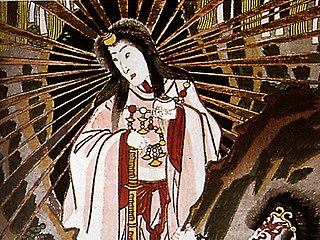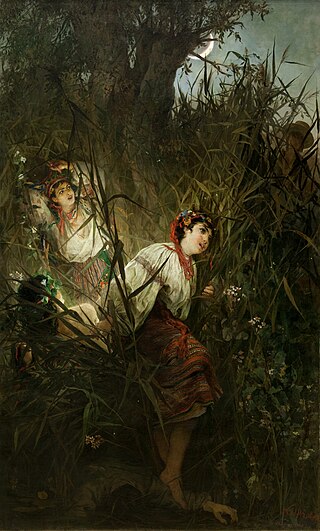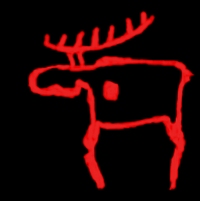Related Research Articles
Latvian mythology is the collection of myths that have emerged throughout the history of Latvia, sometimes being elaborated upon by successive generations, and at other times being rejected and replaced by other explanatory narratives. These myths stem from folk traditions of the Latvian people and pre-Christian Baltic mythology.
Finnish mythology is a commonly applied description of the folklore of Finnish paganism, of which a modern revival is practiced by a small percentage of the Finnish people. It has many features shared with Estonian and other Finnic mythologies, but also shares some similarities with neighbouring Baltic, Slavic and, to a lesser extent, Norse mythologies.

The Bannik is a bathhouse (banya) spirit in Slavic mythology. He is usually described as a small, naked old man with a long beard, his body covered in the birch leaves left over from well used bath brooms. Many accounts also claim that he is a shapeshifter and can appear as a local person to someone who stumbles across him, or even as a stone or coal in the oven heating the bathhouse. Slavic bathhouses resemble saunas, with an inner steaming room and an outer changing room. A place where women gave birth and practiced divinations, the bathhouse was strongly endowed with vital forces. The third firing was reserved for the bannik, and, given his inclination to invite demons and forest spirits to share his bath, no Christian images were allowed lest they offend the occupants. If disturbed by an intruder while washing, the bannik might pour boiling water over him, or even strangle him.

Japanese mythology is a collection of traditional stories, folktales, and beliefs that emerged in the islands of the Japanese archipelago. Shinto traditions are the cornerstones of Japanese mythology. The history of thousands of years of contact with Chinese and Indian myths are also key influences in Japanese religious belief.

Deer have significant roles in the mythology of various peoples located all over the world, such as object of worship, the incarnation of deities, the object of heroic quests and deeds, or as magical disguise or enchantment/curse for princesses and princes in many folk and fairy tales.

Other than the many gods and goddesses of the Slavs, the ancient Slavs believed in and revered many supernatural beings that existed in nature. These supernatural beings in Slavic religion come in various forms, and the same name of any single being can be spelled or transliterated differently according to language and transliteration system.

Finnic paganism is the indigenous pagan religion in Finland, Karelia, Ingria and Estonia prior to Christianisation. It was a polytheistic religion, worshipping a number of different deities. The principal god was the god of thunder and the sky, Ukko; other important gods included Jumo (Jumala), Ahti, and Tapio. Jumala was a sky god; today, the word "Jumala" refers to all gods in general. Ahti was a god of the sea, waters and fish. Tapio was the god of forests and hunting.
Estonian mythology is a complex of myths belonging to the Estonian folk heritage and literary mythology. Information about the pre-Christian and medieval Estonian mythology is scattered in historical chronicles, travellers' accounts and in ecclesiastical registers. Systematic recordings of Estonian folklore started in the 19th century. Pre-Christian Estonian deities may have included a god known as Jumal or Taevataat in Estonian, corresponding to Jumala in Finnish, and Jumo in Mari.

Hantu is the Malay and Indonesian word for spirit or ghost, sometimes it is also the Tagalog word for ghost. In modern usage it generally means spirits of the dead but has also come to refer to any legendary invisible being, such as demons. In its traditional context the term also referred to animistic nature spirits or ancestral souls. The word is derived from Proto-Malayo-Polynesian *qanitu and Proto-Austronesian *qaNiCu. Cognates in other Austronesian languages include the Micronesian aniti, Lio language nitu, Yami anito, Taivoan alid, Seediq and Atayal utux, Bunun hanitu or hanidu, Polynesian aitu or atua, and Tsou hicu among the Formosan languages. In terms of concept and place in traditional folklore, it is most similar to the Filipino anito.
Kaleva – also known as Kalevi or Kalev – and his sons are important heroic figures in Estonian, Finnish and Karelian mythology. In the Finnish epic the Kalevala, he is an ancient Finnish ruler. In Estonian mythology and Friedrich Reinhold Kreutzwald's epic poem Kalevipoeg, King Kalev was the father of King Kalevipoeg and the husband of Linda.
The earliest mentioning of Estonian singing dates back to Saxo Grammaticus' Gesta Danorum. Saxo spoke of Estonian warriors who sang at night while waiting for a battle. Henry of Livonia at the beginning of the 13th century described Estonian sacrificial customs, gods and spirits. In 1578 Balthasar Russow described the celebration of midsummer (jaanipäev), the St. John's Day by Estonians. In 1644 Johann Gutslaff spoke of the veneration of holy springs and J.W. Boecler described Estonian superstitious beliefs in 1685. Estonian folklore and beliefs including samples of folk songs appear in Topographische Nachrichten von Liv- und Estland by August W. Hupel in 1774–82. J.G von Herder published seven Estonian folk songs, translated into German in his Volkslieder in 1778 and republished as Stimmen der Völker in Liedern in 1807.

West African mythology is the body of myths of the people of West Africa. It consists of tales of various deities, beings, legendary creatures, heroes and folktales from various ethnic groups. Some of these myths traveled across the Atlantic during the period of the Trans-Atlantic slave trade to become part of Caribbean, Cuban and Brazilian mythology.
Komi mythology is the traditional mythology of the Komi peoples of northern Russia.

Invented traditions are cultural practices that are presented or perceived as traditional, arising from the people starting in the distant past, but which in fact are relatively recent and often even consciously invented by identifiable historical actors. The concept was highlighted in the 1983 book The Invention of Tradition, edited by Eric Hobsbawm and Terence Ranger. Hobsbawm's introduction argues that many "traditions" which "appear or claim to be old are often quite recent in origin and sometimes invented." This "invention" is distinguished from "starting" or "initiating" a tradition that does not then claim to be old. The phenomenon is particularly clear in the modern development of the nation and of nationalism, creating a national identity promoting national unity, and legitimising certain institutions or cultural practices.

Ghostlore refers to the body of folklore and traditional beliefs surrounding ghosts and hauntings. These tales often feature spirits of the deceased who are believed to linger in the physical world, either to communicate with the living or to seek vengeance for past wrongs. Ghostlore is a widespread phenomenon, with stories of hauntings and ghostly encounters found in cultures around the world.

In Slavic paganism there are a variety of female tutelary spirits associated with water. They have been compared to the Greek Nymphs, and they may be either white (beneficent) or black (maleficent). They may be called Boginki, Navki, Rusalki, and Vily.

Metsaema is the mother spirit of the forest in Estonian mythology.

Pseudo-mythology are myths and deities which do not exist in genuine mythology and folklore or their existence is doubtful or disproved. It may be created by researchers who liberally interpret scarce sources.
References
- ↑ Paulson, Ivar (1965). "Outline of Permian Folk Religion". Journal of the Folklore Institute. 2 (2): 162. doi:10.2307/3813832. JSTOR 3813832.
- ↑ Gustaf, Lofstedt, Torsten Martin (1993). Russian legends about forest spirits in the context of northern European mythology. University of California, Berkeley. pp. 61, 93, 245. OCLC 892822507.
{{cite book}}: CS1 maint: multiple names: authors list (link) - ↑ "Mātes". Latviešu folklora (in Latvian). 2012-10-18. Archived from the original on 2012-10-18. Retrieved 2021-05-21.
- ↑ Gustaf, Lofstedt, Torsten Martin (1993). Russian legends about forest spirits in the context of northern European mythology. University of California, Berkeley. pp. 63, 150, 152. OCLC 892822507.
{{cite book}}: CS1 maint: location missing publisher (link) CS1 maint: multiple names: authors list (link) - ↑ Paulson, Ivar (1965). "Outline of Permian Folk Religion". Journal of the Folklore Institute. 2 (2): 162. doi:10.2307/3813832. JSTOR 3813832.
- ↑ Paulson, Ivar (1965). "Outline of Permian Folk Religion". Journal of the Folklore Institute. 2 (2): 165. doi:10.2307/3813832. JSTOR 3813832.
- ↑ Gustaf., Lofstedt, Torsten Martin (1993). Russian legends about forest spirits in the context of northern European mythology. University of California, Berkeley. pp. 59–60. OCLC 892822507.
{{cite book}}: CS1 maint: multiple names: authors list (link) - ↑ Gustaf, Lofstedt, Torsten Martin (1993). Russian legends about forest spirits in the context of northern European mythology. University of California, Berkeley. pp. 67–124. OCLC 892822507.
{{cite book}}: CS1 maint: multiple names: authors list (link) - ↑ Paulson, Ivar (1965). "Outline of Permian Folk Religion". Journal of the Folklore Institute. 2 (2): 163. doi:10.2307/3813832. JSTOR 3813832.
- ↑ Kreutzwald, Friedrich Reinhold (1854). Der Ehsten abergläubische Gebräuche, Weisen und Gewohnheiten, mit auf die ... (in German). Oxford University. p. 81.
- ↑ Västrik, Ergo-Hart (1998). "Clothed Straw Puppets in Estonian Folk Calendar Tradition: a Shift From Cult to Joke". Folklore: Electronic Journal of Folklore (7): 3.